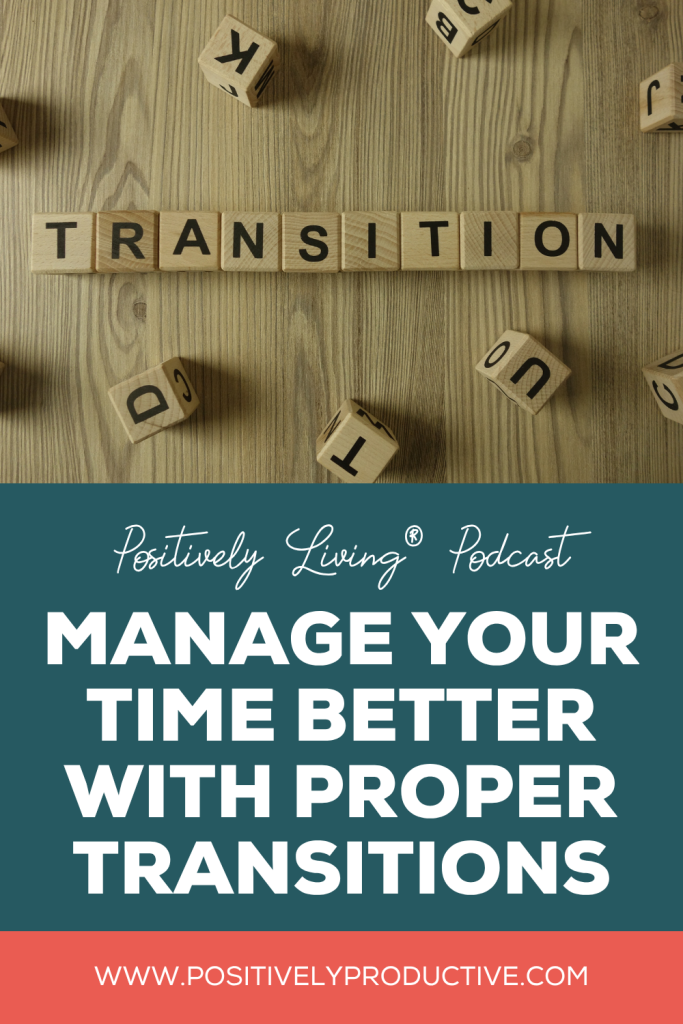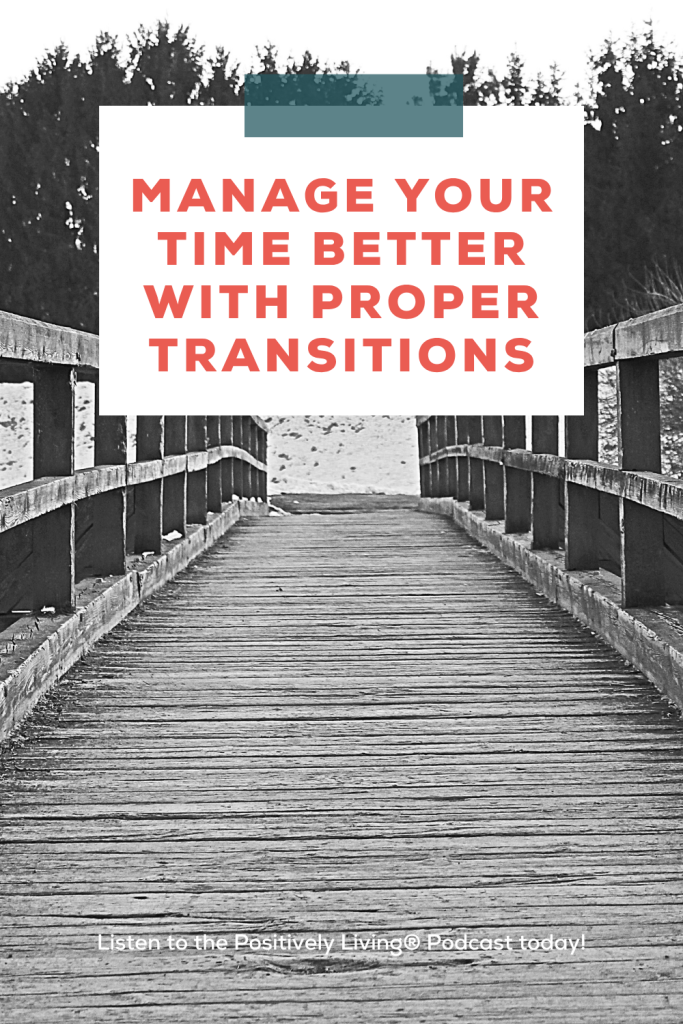Do you jump from one task to the next feeling scattered, tense, or overwhelmed? We spend so much time planning our work that we often forget about the essential space in between. Ignoring this transition time can lead to frustration and exhaustion (which leads to burnout) and can negatively impact your life in so many ways. It’s often a missing piece in your time management puzzle, but it doesn’t have to be.
In this episode of the Positively LivingⓇ Podcast, I discuss the power of transition time. I’ll explain the science behind why our brains need buffer time to shift between different modes and share simple, actionable ways to build these transitions into your day, whether they’re micro-moments or longer routines.
I cover the following topics:
- Why skipping transitions takes a surprising toll on your nervous system, leading to burnout.
- How our brains need time to shift from a sympathetic (“fight or flight”) state to a parasympathetic (“rest and digest”) state (and back again).
- The importance of micro-transitions and rituals to signal change to your brain, even if it’s just a deep breath or a sip of water.
- Practical strategies like using physical shifts, auditory timers, and shutdown routines to make transitions intentional and effective.
- A mindset shift to stop seeing transition time as wasted time and start seeing it as protective, restorative, and focus-building.
Remember, making the most of every moment doesn’t mean working every moment. Transition time isn’t a luxury; it’s an essential part of your productive process.
Why You’re Missing the Best Part of Productivity: The Power of Transition Time
Do you jump from one task to the next feeling scattered, tense, or overwhelmed? We spend so much time planning our work that we often forget about the essential space in between. Ignoring this transition time can lead to frustration, overwhelm, and burnout. It is a missing piece in your time management puzzle, but it does not have to be. What if adding a few minutes of buffer time could make you feel more focused, present, and calm? What if that “extra” time you think you cannot spare is actually the key to making everything else work better?
This article is for you if you feel like your days are a series of jarring jumps, if you struggle to shift gears, or if you simply want a smarter way to manage your time and energy. We will discuss the science behind why transitions matter and give you simple, actionable ways to build them into your day. Get ready to stop punishing yourself for needing space and start making the most of every moment.
The Science of Shifting Gears
To understand why transitions matter so much, you need to know a little about your nervous system. When you are in “go-mode,” tackling a tough problem or multitasking, your brain is in a sympathetic state (often called “fight or flight”). This is great for focus, but it is not sustainable for long periods. When it is time to rest, eat, or be creative, your body needs to shift to a parasympathetic state (often called “rest and digest”). This is where your body recovers and prepares for what’s next.
Here is the challenge: you cannot flip from one state to the other like a light switch. You need space to signal a shift to your brain. When you skip a transition, you may stay stuck in the stress cycle. This is why you might carry the tension of a frustrating meeting into your lunch break and not feel rested afterward. Or why you snap at a loved one after a hard workday. Your nervous system never got the message to change gears.
Quick Wins & Key Takeaways:
- Your nervous system needs time to shift between its “fight or flight” and “rest and digest” modes.
- Skipping transitions can keep you stuck in a stress cycle, carrying tension from one activity to the next.
- Proper transitions signal to your brain that it is time to shift, helping you be fully present for what is next.
- Ignoring transition time can lead to frustration, overwhelm, and burnout.
Your Guide to Smoother Transitions
Transition time is not wasted time; it is a protective, restorative, and focus-building part of your day. You do not need a lot of buffer time to make a difference; even five to ten minutes can help your brain reset. Here are some ideas to build these essential pauses into your routine.
Use Micro-Transitions
You do not even need five minutes to create a better shift. A single deep breath, standing up to stretch, or sipping water are all tiny rituals that signal change to your brain. These micro-transitions can help you let go of what came before and be present for what is next.
Create a Shutdown Routine
Consider creating routines that “open” or “close” a part of your day. A successful example is a “shutdown” routine after work where you tidy your desk to neutral and make notes for what to work on next. This gets things out of your brain and helps you shift your mindset from work mode to home mode. This tactic helped one client stop working so much overtime.
Make Physical Shifts
Changing your environment, music, or lighting can help your brain distinguish between modes. You can also use physical movement to help your brain shift. A short walk after lunch, for example, can help with digestion and get blood flowing for focused work instead of brain fog. For a calming approach, lying on your back for a few minutes can reduce stress in a similar way to meditation.
Use Timers
Timers are a great way to be fully present because they free you from watching the clock. A soft chime or countdown clock can be a helpful accessory in applying a transition without worrying you are taking too long. They are especially helpful for neurodivergent brains, but I believe everyone can benefit from them.
Identify the Transition Out Loud
Sometimes, simply saying what you are transitioning to can be a mindset shift. For example, I have gotten into the habit of having a later morning coffee and actually stopping to drink it for a few minutes instead of taking it on the go. This simple ritual creates an effective transition and helps me enjoy my coffee more.
Make Transition Time a Priority
The biggest mindset shift I want to offer you is this: transition time is not wasted time. It is a kindness and an act of self-compassion that acknowledges you are human, not a robot. By building in these intentional moments, you are making the most of your time, energy, and resources.
Here is your action plan to start building smoother transitions into your day:
- Use Micro-Transitions: Begin with a single deep breath or a sip of water between tasks.
- Create a Routine: Develop a simple shutdown routine for your workday.
- Make a Physical Shift: Try a short walk after lunch or a change of environment.
- Use a Timer: Set a gentle timer to signal when a work period ends and a transition begins.
- Identify Your Pause: Say out loud that you are taking a break, even for something as simple as coffee.
Pick one idea and experiment this week with just one mindful transition each day. Let’s stop punishing ourselves for needing space and normalize giving ourselves what we actually need to show up well.
Thank you for listening! If you enjoyed this episode, take a screenshot of the episode to post in your stories and tag me! And don’t forget to follow, rate, and review the podcast and tell me your key takeaways!
Learn more about Positively LivingⓇ and Lisa at https://positivelyproductive.com/podcast/
Could you use some support? The Quickstart Coaching session is a way to get to know your productivity path, fast! A speed-round strategy session is perfect for a quick win and to see what coaching can do, the Quickstart will encourage and inspire you to take intentional, effective action! Go to https://www.positivelyproductive.com/plpquick for a special listener discount!
CONNECT WITH LISA ZAWROTNY:
LINKS MENTIONED IN THIS EPISODE:
Ep 73 with Stacy Kessler
Ep 271 on Avoiding Tasks
(Find links to books/gear on the Positively Productive Resources Page.)
Dance Song Playlist V1, V2, V3
Music by Ian and Jeff Zawrotny
Start your own podcast with Buzzsprout!











